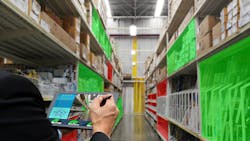Better together: AI and real-time location systems
What if you could know the location of every important asset in the workplace, warehouse, or hospital with up-to-the-minute precision? How would this insight make your business more efficient, your people more productive, your customers more satisfied, and your shareholders happier?
Real-time location systems (RTLS) are a set of technologies that enable the location of people, tags, assets, or objects to be found, tracked, or monitored. It uses tracking devices, a communications network, geospatial analysis, and a centralized management system to enable administrators and users to interact with location information in real-time and to study tracking data for patterns that indicate problems or opportunities for improvement.
But these systems are only useful if they are accurate. Every time a user engages with an RTLS system, they must be confident in finding what they’re looking for with exactness. Artificial intelligence (AI) can now bring a refined level of accuracy to RTLS in a new way.
RTLS in practice across industries
RTLS use cases occur across a wide spectrum of industries. Take manufacturing, where the cost of an hour of downtime can reach as high as $2 million. Imagine an automotive manufacturer that uses asset tags to find forklifts and speed them to the assembly line, or a company that tracks components as they travel through the workflow. If every minute of disrupted production costs more than $30,000, saving just 30 minutes of time can add up to nearly $1 million in return.
A company that builds products for multiple clients on a contract basis can use RTLS to create geofences and ensure sensitive assets are kept within designated areas of its facility. As a result, its customers’ intellectual property and trade secrets aren’t compromised.
In the retail industry, a company that uses RTLS to track valuable merchandise within its warehouse facility can manage inventory more efficiently. In health care, a client that operates senior living facilities that gives trackable badges to its residents and care staff can monitor the location of dementia patients and locate doctors and nurses quickly in emergencies.
RTLS is becoming more flexible and affordable. Bluetooth Low Energy (BLE), a more power-efficient version of the ubiquitous short-range communications technology, allows devices to run for months or even years on a single button power cell. The technology has now been incorporated into existing lighting and energy management systems, enabling customers to upgrade their existing infrastructure with RTLS capabilities without large-scale replacements.
Machine learning, an RTLS game-changer
Machine learning (ML), an AI component, is the technical foundation for significant development in RTLS technologies. While traditional RTLS provides valuable insights into asset movement, the incorporation of ML takes location prediction to a new level of accuracy and intelligence. Additionally, an ML-based system can resolve many of the hinderances of traditional. It can also handle the noisy signal nature or variation of BLE signals, including the impact of infrastructure, like building materials, and interference multipath noise.
A ML-based RTLS is also more flexible, performing better in the complex and dynamic spaces of real business operations. It is even suitable for manufacturing and warehouses with high levels of electro-magnetic noise (RF interference). Once the model is trained and has met accuracy targets, it is deployed to production for live inference. A ML-based RTLS solution retrains the ML model when physical changes occur to the facility, eliminating the time and cost for gateway or sensor updates. The result is a more reasonable price point than other RTLS technologies.
The AI-driven efficient workplace
The implications of RTLS for process-intensive industries like manufacturing, warehousing and logistics, and health care are enormous. Complicated processes that have long been documented with spaghetti-like diagrams can be replaced by workflows based on real-world observation. ML can be applied to analyze real-world data, streamline processes, and fine-tune them continuously. Sensors measuring factors such as temperature, vibration, and pressure can enable factory operators to practice predictive maintenance, which reduces downtime by servicing equipment before it fails.
AI is revolutionizing business operations across the board—and it still has not reached its full potential. The pairing of AI/ML and RTLS technologies is a powerful factor in critical business decisions and operational excellence across multiple industry sectors, with bottom-line impacts.
Currently, ML-based RTLS technologies are not available off the shelf. Rather, they require hardware and software that must be purchased. However, the system can be implemented rapidly. A hospital administrator in a health care setting or an operations manager in manufacturing or warehouse settings can access RTLS via a live dashboard that shows a facility map with asset locations displayed in real time and receive alerts when assets transition between different zones/areas. Furthermore, a company can integrate these asset locations into other management software, such as a building management, asset maintenance, workflow management, or security system.
This article has been edited since first publication.
About the Author

Philipp Wehn
Philipp is a lover of technology—more precisely, technology with purpose. As VP Innovation and Venture Building at Siemens Enlighted, he leads the innovation program and early stage ventures. Located in Silicon Valley, he is a thought leader in corporate development and enterprise AI and has been named to the "Top 40 Under 40" in Germany.
